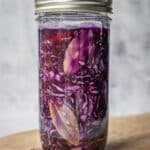Red Cabbage Sauerkraut (Simple Fermented Cabbage)
This 5-ingredient recipe for Red Cabbage Sauerkraut (Lacto-fermented red cabbage) is a slight twist on traditional sauerkraut. It is a jumping-off point into the wonderful world of fermentation. It’s easy to prepare and incredibly rewarding.
Servings: 15 Servings per jar
Cost: $5
Equipment
- ¾ quart mason jar (24 fl oz mason jar)
- Regular canning jar lid
Ingredients
- 600 grams Red Cabbage, shredded finely - 21ounces – about half a medium-sized head of red cabbage
- 15 grams Kosher, pickling or sea salt - about 1 tablespoon
- 2 grams Caraway Seeds - 1 teaspoon
- 2 grams Mustard seeds - 1 teaspoon
- 2 Bay leaves
Instructions
- Chop. Start by removing the outer leaves of the red cabbage and cutting your head of cabbage in half. Cut one half into quarters (save the other half for another recipe or double this one). Remove the tough core and finely chop the cabbage quarters into really thin slices. You can use a sharp knife or a mandoline.
- Weigh. Place a large bowl on a kitchen scale and zero it. Transfer the chopped cabbage to the bowl and weight it. This will help you calculate the amount of salt needed.
- Salt. Multiply the weight of your cabbage in grams by 0.025. This is the amount of salt you need to add to the cabbage. Make sure to tare (or zero) the scale before adding the salt.
- Massage. With clean hands, massage the sliced cabbage with the salt for 2-3 minutes. Set aside.
- Liquid. After about 15 minutes you should start seeing purple water at the bottom of the bowl. This is a good sign.
- Season. Add the loose spices and mix them in. I suggest you keep the bay leaves whole and add them to the jar in the next step.
- Pack. Transfer the wilted red cabbage and all the juice to a clean mason jar. Using a tamper or wooden spoon, push down. Place the bay leaves against the sides of the jar so they don’t get crushed when tamping. You should see purple liquid come up.
- Cover. Add a piece of cabbage leaf on top of the shredded cabbage mixture. This will prevent any small pieces of cabbage from floating up.
- Weight. Apply the fermentation weight and press down. If you don’t have fermentation weights you can use a Ziplock bag filled with water or marbles to weigh down the cabbage.
- Cover. Cover the jar with a fermentation lid, or standard lid if that’s all you have (if you use a standard lid you will have to burp the jar once or twice a day during the fermentation process to release the built-up gasses).
- Check the liquid level. The next day, check to make sure there is enough liquid covering all the cabbage. If not, top off with lightly salted water just enough to cover the cabbage.
- Ferment. Ferment on a counter away from direct sunlight for at least 7 days. After 7 days, taste your sauerkraut. If you want to continue fermenting it, put the weight and lid back on. You can ferment for another week or even more if you really like your kraut sour. If you’re happy with the taste, remove the weight, fermentation lid and cabbage leaf. Apply a standard lid and place the kraut in the fridge.
Notes
Refer to the blog post above for step-by-step photos.
Additions: You can add juniper berries, coriander seeds or fennel seeds to the ferment if you wish.
Fermenting time depends on your personal taste. Some people prefer a milder sauerkraut, so a 3-4 day fermentation works for them. Others prefer a more traditional, longer ferment (2 weeks or even longer).
Important notes:
- While the cabbage is fermenting it is best to keep it on the counter away from direct sunlight. You can also keep it in a dark place like a cabinet if you wish. The ideal fermenting temperature is 60°F to 75°F (15°C to 24°C). In other words, room temperature.
- Finished sauerkraut should be kept in the fridge. This is the safest way to store it and it will last for several months this way.
Nutrition
Calories: 14kcal | Carbohydrates: 3g | Protein: 1g | Fat: 0.1g | Saturated Fat: 0.01g | Polyunsaturated Fat: 0.1g | Monounsaturated Fat: 0.04g | Sodium: 398mg | Potassium: 100mg | Fiber: 1g | Sugar: 2g | Vitamin A: 448IU | Vitamin C: 23mg | Calcium: 20mg | Iron: 0.4mg
